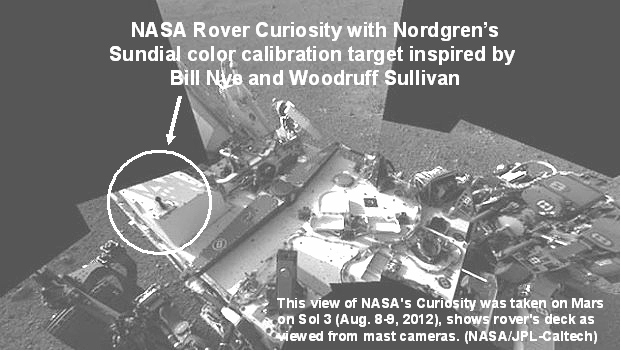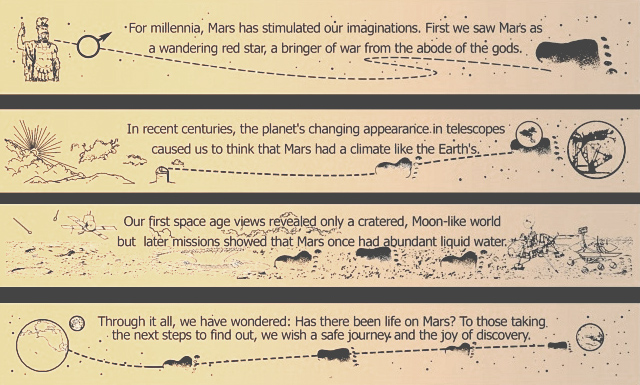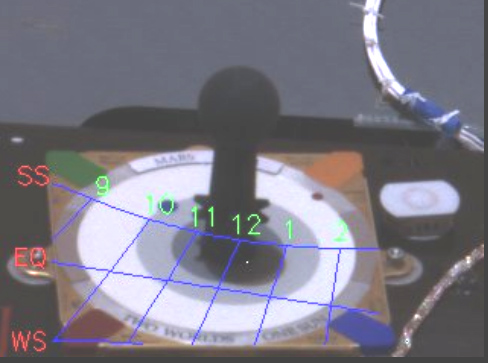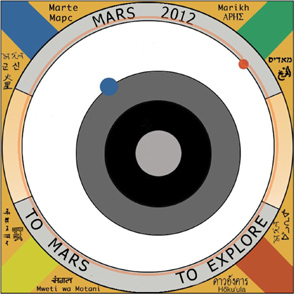 With the successful landing of the NASA rover Curiosity, another sundial is on planet Mars. Turning the color calibration target into a sundial was the idea of Bill Nye, the Science Guy, and Professor Woodruff Sullivan at the University of Washington, originally hailed by “Two Worlds – One Sun”
With the successful landing of the NASA rover Curiosity, another sundial is on planet Mars. Turning the color calibration target into a sundial was the idea of Bill Nye, the Science Guy, and Professor Woodruff Sullivan at the University of Washington, originally hailed by “Two Worlds – One Sun”
THese two sundial enthusiasits have been encouraging people around the world to make their own sundials and collectively participate using webcams to tell solar time around the earth. See: http://sundials.org/index.php/features/168-curiosity-sundial-launched and read the details of the sundial with the following PDF download: MarsDialReport.pdf
Curiosity’s calibration target was created by Tyler Nordgren at the University of Redlands. However Nordgren and a group of six scientists, astronomers, educators, and artists (including Nye and Sullivan) went further. Said Nordgren, "But we thought, why not use this very dry boring technical piece of equipment, and turn it into something beautiful and evocative?"
The calibration target turned sundial is actually a leftover from NASA’s Mars Exploration Rover (MER) Spirit. Along the edges of the sundial MARS is written out in 16 different languages. The sundial’s center represents the sun with a concentric grey ring for the earth’s nearly circular orbit and a displaced white ring for Mars eccentric orbit. The positions of Earth and Mars, shown respectively by a blue and red dot are placed for the date of impact at 10:32 pm Aug 5th PDT. Every MARS sundial has a date and motto. “It's sundial tradition,” says Nordgren. Curiosity says "MARS 2012" and "TO MARS TO EXPLORE."
Each home-plate color slice has a phrase describing what the mission means for human exploration. It reads:
“For millennia, Mars has stimulated our imaginations. First we saw Mars as a wandering red star, a bringer of war from the abode of the gods. In recent centuries, the planet's changing appearance in telescopes caused us to think that Mars had a climate like the Earth's. Our first space age views revealed only a cratered, Moon-like world, but later missions showed that Mars once had abundant liquid water. Through it all, we have wondered: Has there been life on Mars? To those taking the next steps to find out, we wish a safe journey and the joy of discovery."

Dr. Woody Sullivan discussed the history of the Mars Dials on a recent Sundial Digest forum (11 Aug 2012, Vol. 80, Issue 8) https://lists.uni-koeln.de/mailman/listinfo/sundial
“[Above] is the first image of the latest "Mars Dial", which indeed is the calibration device for the main camera ("Mastcam") on Curiosity Rover, which landed safely in Gale Crater on Mars 5 days ago (hurrah!)."
"The Mars Dials were originally fabricated in 1999 for the Mars Rovers Spirit and Opportunity, which landed in 2004, and the latter of which is STILL working over 8 years later. To date over 35,000 images have been taken of the two Mars Dials - the most photographed thing on Mars! As mentioned below, I was intimately involved in all aspects of making these calibration devices into working sundials - design, fabrication, operations, etc. However, because of other commitments I chose not to be part of any Curiosity efforts, so my report in the following paragraph is that of a (very) interested observer."
"In order to save some money, the Curiosity Mars Dial is a slight modification of one of the 6 copies that we made in 1999. A couple of magnets were added (to try to repel dust), new plates were put on it to change various wording such as the date and, in particular, the motto. The motto is now "To Mars To Explore" rather than the previous "Two Worlds One Sun". But the biggest difference is that, as far as I know, no one is ever going to superimpose the hour/date lines so that it can actually be used as a sundial! And yet NASA's publicity continues to call it a sundial.....But I'm still very happy to see the first images of it….”

 The image here is from the Mars Exploration Rover Spirit (look carefully for the motto “Two Worlds One Sun”) and according to a NASA news release, “was processed by students in the Red Rover Goes to Mars program to impose hour markings on the face of the dial. The position of the shadow of the sundial's post within the markings indicates the time of day and the season, which in this image is 12:17 p.m. local solar time, late summer. A team of 16 students from 12 countries were selected by the Planetary Society to participate in this program. This image was taken on Mars by the rover's panoramic camera.” [Image was produced at Cornell University - Image Nr: PIA05017]
The image here is from the Mars Exploration Rover Spirit (look carefully for the motto “Two Worlds One Sun”) and according to a NASA news release, “was processed by students in the Red Rover Goes to Mars program to impose hour markings on the face of the dial. The position of the shadow of the sundial's post within the markings indicates the time of day and the season, which in this image is 12:17 p.m. local solar time, late summer. A team of 16 students from 12 countries were selected by the Planetary Society to participate in this program. This image was taken on Mars by the rover's panoramic camera.” [Image was produced at Cornell University - Image Nr: PIA05017]
For more details of the Curiosity sundial, read an interview with Tyler Nordgren: http://www.popsci.com/science/article/2012-08/mars-rover-curiosity and http://wtvr.com/2012/08/03/nasa-mars-rover-curiosity-will-land-early-monday/
Read more about Curiosity’s instruments at http://www.nasa.gov/mission_pages/mars/main/index.html
